
Purchase of Historic Trench Mine Pending, Lead Queen Cleanup Stalled
|
|
|
|

|
|
|
|
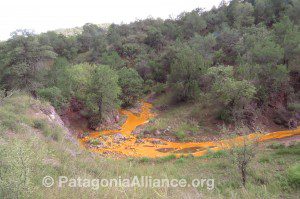

Toxic overflow from the historic Lead Queen mine in the Patagonia Mountains drains towards Harshaw Creek.
The Coronado National Forest, Sierra Vista Ranger District hosted a community meeting in Patagonia, Arizona on April 28. The Lead Queen Mine cleanup plan was by presented by Floyd Gray of United States Geological Survey (USGS), and Eli Curiel of the Forest Service.
The Lead Queen was an underground mine for lead, silver, zinc, copper and gold that started in 1898 and was abandoned after 1940. After heavy rains in September 2014, members of PARA discovered and reported the leaking mine site, located approximately 6 miles south of Patagonia, Arizona. In December, the Arizona Department of Environmental Quality served the Forest Service with two notices of violation for the toxic mine spill. The Forest Service issued a “Time Critical Removal Action Approval Memorandum” in February to mitigate the spill and its potential threats to public health and welfare, water and wildlife. Clean up was scheduled to start Spring 2015, before monsoon rains could potentially wash contamination further downstream.
Floyd Gray gave an overview of his findings from sampling and testing the water, soil, and waste rock around the abandoned mine site. It was also deduced that there is more than one source of leakage from the mine site. One source was identified by its extreme concentration of iron while the other source is high in aluminum. All of the tested samples came back with very high levels of contamination from hazardous heavy metals such as arsenic and lead. In one water sample, the heavy metal levels were 20 times higher than the allowable drinking water standards. It was also determined that the mine contamination traveled 9/10th of a mile downstream.
The studies at the Lead Queen site to determine all of the sources of contamination has lead to a larger, ongoing study of the watersheds in the Patagonia Mountains by USGS and the Forest Service.
Eli Curiel detailed the plans to plug the six abandoned tunnels and shafts of the Lead Queen mine site with polyurethane foam. The waste rock piles laced with toxic heavy metals will be consolidated into a new location above the watershed and capped with clean fill to prevent future contamination. The polluted sediment in the waterway will be removed with the aid of a series of eleven gabion walls across the drainage filled with zeolite to capture and hold the heavy metals. The clean up area comprises five acres on the Coronado National Forest in the Patagonia Mountains. The mine site will require ongoing monitoring and maintenance, essentially forever.
The cost to taxpayers has not yet been determined. The clean up project has not yet gone out to bid. It’s expected to take up to 120 days with work possibly starting this summer.
More information can be obtained from the Forest Service Project On-Scene Coordinator, Eli Curiel at 520-388-8413.
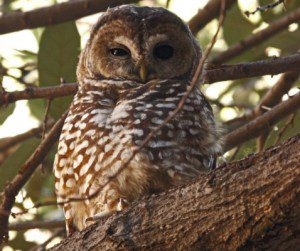
Mexican Spotted Owl ©Gooch Goodwin
At the public meeting, an update was given on Regal Resources’ Sunnyside mining exploration project in the Patagonia Mountains by Forest Service Geologist Mindy Vogel. Conspicuously absent from Vogel’s overview was the ongoing litigation between Defenders of Wildlife and PARA against the Forest Service and US Fish and Wildlife for the unlawful approval of this project.
For the present time, no work is allowed at the Sunnyside site between March 1 and Oct 1, 2015 because of nesting Mexican spotted owls and Yellow-billed cuckoos in the area, according to the Forest Service Decision Memo.
No questions were permitted during any of the presentations. Audience members were required to seek out Forest Service and USGS personnel after all presentations were complete to ask questions. It is a format that we find effectively prevents members of the community from getting all of their questions answered and learning the most information possible.
Forest Service geologist Margie DeRose gave an overview and an update of the expected timeline of the AZ Mining Inc (aka Wildcat Silver, AMI) Hermosa mining exploration proposal in the Patagonia Mountains on the Coronado National Forest. The final Environmental Assessment and draft decision is estimated for release in October 2015 – over a year past the original timeline. A 45 day public objection period will follow.
Meanwhile, AZ Mining Inc / Wildcat Silver board chairman Richard Warke is privately funding more mine exploration drilling on their privately owned land. AZ Mining Inc / Wildcat Silver is now claiming that deposits for lead, zinc and silver exist for an additional mine at the Hermosa project, referred to as Hermosa North West.
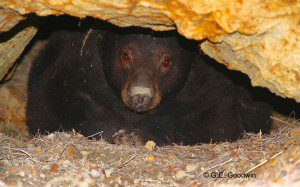
The AZ Mining Inc (Wildcat Silver) Hermosa drilling project timeline was just pushed back–now almost a full year behind the previous schedule. We couldn’t have planned a better holiday gift! The release of the Hermosa Environmental Assessment (EA) and Draft Decision is now estimated for July 2015, which would then trigger a 45 day deadline for objections. If you commented on the Hermosa project, you will be able to participate in the objection process. PARA has successfully delayed AZ Mining Inc / Wildcat Silver–and all other mining companies–from drilling on public land in the Patagonia Mountains since 2011.

Save my home in the Patagonia Mountains. ©Gooch Goodwin
Billie the Black Bear makes her home in the Patagonia Mountains. Open pit mining would destroy her home and the water that we all depend upon. Your gift to the Patagonia Area Resource Alliance empowers us to keep new mining activity off of public land in the Patagonia Mountains–successfully since 2011!
Read more about our most recent Activities and Accomplishments.
Your donations also make it possible for us to organize community involvement and action so that we can protect the Patagonia Mountains, wildlife and habitats, our waterways and our communities.
Please consider making a donation to PARA this year to support and grow this critical work in the Patagonia Mountains: patagoniaalliance.org/donations/
A big thank you to everyone who has already donated this year!
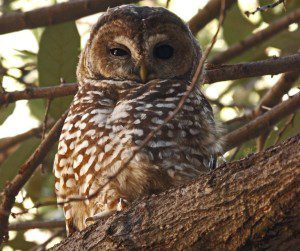
Mexican Spotted Owl © Glen E Goodwin
The Forest Service approved the Sunnyside mineral drilling proposal by Regal Resources in the Patagonia Mountains, even though it directly threatens the imperiled Mexican spotted owl in the most sensitive area of their habitat–their roosting and nesting areas. As a result, we filed suit in federal court with Defenders of Wildlife for that unlawful approval, which violates environmental laws and poses potential threats to additional endangered species and the safety of drinking water for local residents.
We are very fortunate to have a group of amazingly committed community members and generous donors supporting our work.
We’ve just exceeded our year-end goal of raising $19,000! We on our way to reaching our entire 2015 operating budget. Thank you!
The work necessary to keep mining out of the Patagonia Mountains a reality is only possible because of your financial support.
Consider making an automatic, monthly donation to PARA on your credit card through PayPal.
Every single contribution makes a sizable difference to our organization and ultimately for our community.
It is only because of the generous support from people like you that we can undertake this critical work. Thank you!

It’s hard to believe that the end of the year is nearly upon us! When 2014 began, your friends, neighbors and colleagues here at the Patagonia Area Resource Alliance (PARA) were gearing up for a busy year promoting the incredible beauty, community, and natural heritage of the Town of Patagonia and the Patagonia Mountains. Little did we know what a whirlwind year it would be! The past eleven months have seemingly sped by while we have been advocating to protect this amazing place that we all treasure from the multiple threats that exploratory drilling and mining pose to our small community.
PARA was formed in 2011 to educate and engage the community about the risks and realities of mining, to promote local sustainable economies, to better understand our precious and imperiled natural resources such as clean water and wildlife, and to actively advocate for the protection of those resources in concert with Patagonia’s distinct and serene rural way of life.
You have helped us along the way this year! You have volunteered, come to public meetings, wrote letters, monitored wildlife, and participated in the NEPA process. Together, we have contributed over 2500 volunteer hours already in 2014!
It has been another amazing and transforming year for PARA, but we have so much more to do! PARA runs on a shoestring budget with the human power of an almost entirely volunteer workforce and our two person outreach team–budgeted for only 30 hours per week. We’d like to do so much more! Please consider making a donation to PARA this year to support and grow this critical work in our community.
Filed a complaint in federal court in October with Defenders of Wildlife against the Forest Service and the Fish and Wildlife Service for their unlawful approval of the Regal Resources Sunnyside mineral drilling project in southern Arizona’s Coronado National Forest, in the Alum Gulch area of the Patagonia Mountains. The Sunnyside project approval violates environmental laws and poses a potential threat to endangered species and the safety of drinking water for Patagonia area residents. The Coronado National Forest, Patagonia Mountains and waterways in our region support some of the world’s most imperiled wildlife, including jaguar, ocelot, lesser long-nosed bat, Mexican spotted owl, and yellow-billed cuckoo.
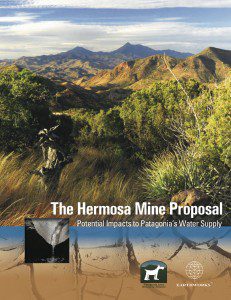 Educating the Community on Mining Risks
Educating the Community on Mining RisksReleased a peer-reviewed report with the national organization EARTHWORKS, “The Hermosa Mine: Potential Impacts to Patagonia’s Water Supply.” The report uses geologic and hydrologic studies from mine developer AZ Mining Inc (Wildcat Silver), the United States Geologic Survey, the Arizona Department of Water Resources, the Town of Patagonia, and others, as well as analyzes historic contamination issues caused by mining in the Patagonia Mountains. We conclude in our report that the seemingly inescapable realities of acid drainage and water consumption impacts pose too great a risk to Patagonia.
Coordinated and submitted NEPA comments on the USFS draft Environmental Assessment for the AZ Mining Inc (Wildcat Silver) Hermosa drilling project with Defenders of Wildlife, Arizona Mining Reform Coalition, Center for Biological Diversity, Earthworks, and Sky Island Alliance. Hosted a community workshop to empower residents to comment on the Hermosa EA comprising of an overview of the Hermosa proposal and its likely impacts; a NEPA presentation and how to comment on an EA by Jenny Neeley, Attorney at Law; and a presentation of area wildlife by Biologist, Sergio Avila, of Sky Island Alliance.
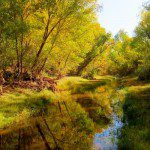
Sonoita Creek
Submitted comments regarding the proposed United States Forest Service Guidelines on Groundwater, advocating for groundwater protection and consideration of potential impacts regarding all agency activities in our National Forests, especially in regards to hardrock mining. Submitted comments to the Environmental Protection Agency regarding the proposed rule defining the “Waters of the U.S.” advocating for protection of ephemeral and intermittent streams. Submitted comments advocating for more designated critical habitat in the Patagonia Mountains for the threatened yellow-billed cuckoo.
To learn more about our 2014 accomplishments and efforts, please take a look at PARA’s “Report to the Community” available on our website at: www.patagoniaalliance.org/our-activities- outreach/
With continued legal assistance from Defenders of Wildlife, PARA strives to hold mining companies, the US Forest Service and all agencies accountable to follow the laws and regulations designed to protect our water, air, surrounding ecosystems and communities. We are positioned to respond to future exploratory mining proposals scheduled for the Patagonia Mountains.
Citizen scientists from the community continue wildlife monitoring efforts in the Patagonia Mountains focusing on areas immediately at risk by proposed mining activities. Data gathered is used to fight mining proposals through species lists, presence of vulnerable species and habitat analysis. Additional collaborations are ongoing with Defenders of Wildlife, EARTHWORKS, Sky Island Alliance and Tucson Audubon to ensure this data is applied to advocacy efforts in the most effective ways.
PARA is strategizing to expand community education activities to grow our base of support and empower concerned residents with potential actions to keep mining out of the Patagonia Mountains. We recognize the need to establish sustainable funding to maintain core functions and seek to expand funding sources. With our additional staff funding in the 2015 budget, we plan to sustain our two person team to continue to expand our outreach beyond our community boundaries. Our 2014 Financial Report is also available online: www.patagoniaalliance.org/our-activities-outreach/
PARA recognizes that the health and economic prosperity of our community are deeply connected to the well-being of the Patagonia Mountains and the Harshaw/Sonoita Creek watershed. They are the source of our drinking water, clean air and the centerpieces that drive our local economy.
There are many needs in our community and many compelling requests for support. We believe one of the most fundamental is protecting our drinking water and our community from the well-known detrimental effects of open pit mining. To that end, PARA is seeking to raise $19,000 by the end of 2014 to support the several ongoing and new initiatives outlined above as we move into 2015. We are fortunate to have a group of amazingly committed community members and generous donors supporting our work, but we are looking to broaden the base of support to ensure not only financial sustainability, but also the ability to impact local, regional and national decision-making on our own behalf.
That’s where you come in. The work necessary to make this vision of 2015 a reality is possible only because of your time and your financial support. Please make a gift today.
Recurring monthly donations can be made securely through PayPal.
Every single contribution makes a sizable difference to our organization and ultimately for our community. It is only because of the generous support from people like you that we can undertake this critical work. Thank you!
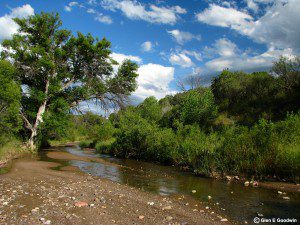
Patagonia Area Resource Alliance
Earthworks
October 28, 2014
 Patagonia – The Hermosa silver mine proposed inside Patagonia, Arizona’s Municipal Supply Watershed could deplete the town’s drinking water and perpetually contaminate area groundwater with acid mine drainage, according to a new peer-reviewed report.
Patagonia – The Hermosa silver mine proposed inside Patagonia, Arizona’s Municipal Supply Watershed could deplete the town’s drinking water and perpetually contaminate area groundwater with acid mine drainage, according to a new peer-reviewed report.
Reviewed* by a USGS scientist and released by the Patagonia Area Resource Alliance and Earthworks, the study also concludes that drinking water wells of surrounding residents are also threatened.
“A mine that threatens our town’s drinking water is a mine that shouldn’t be built,” said Wendy Russell of the Patagonia Area Resource Alliance. She continued, “In Arizona, water is more precious than silver, and especially so after more than a decade of drought.”
Proposed by Canadian exploration company AZ Mining Inc (Wildcat Silver) – a company with no experience operating a mine – Hermosa is proposed at a time when Patagonia is already concerned with dropping groundwater levels and increasing concern about future water supplies.
The 4,000 foot wide and 1,500 foot deep Hermosa silver and manganese mine would consume 670 million to 1.2 billion  gallons of groundwater per year – up to 53 times the amount of water the town uses today — to run the mine within the upper reaches of Harshaw Creek, a portion of Patagonia’s Municipal Supply Watershed. This water consumption will lower the recharge rates for the aquifer on which the town depends, and is also likely to produce acidic runoff, requiring ongoing treatment in perpetuity.
gallons of groundwater per year – up to 53 times the amount of water the town uses today — to run the mine within the upper reaches of Harshaw Creek, a portion of Patagonia’s Municipal Supply Watershed. This water consumption will lower the recharge rates for the aquifer on which the town depends, and is also likely to produce acidic runoff, requiring ongoing treatment in perpetuity.
“If the U.S. Forest Service were to permit the Hermosa mine, this report shows it would jeopardize our community’s drinking water. And for what? For foreign shareholders’ silver,” said Wendy Russell. She continued, “This is a mine proposal that just doesn’t make sense for our community who would actually have to live with it.”
The mine is proposed within the Coronado National Forest, and therefore subject to the 1872 Mining Law. Federal land managers interpret the 1872 Mining Law to require them to permit mines, no matter if the land is better used for other purposes – like protecting a town’s drinking water supply watershed.
“Because the Hermosa mine proposal threatens area water supplies, it obviously should not be permitted,” said report author Pete Dronkers of Earthworks. He continued, “That it’s being considered at all is a strong argument for reforming the 1872 Mining Law to allow the consideration of other potential land uses.”
The report also evaluates the nature of groundwater depletion that is likely under the proposed mine plan, characterizes the impacts of such, and also analyses other known adverse impacts, such as air pollution, endangered species, and other cumulative impacts.
The report, including an executive summary, can be found at: patagoniaalliance.org/report-hermosa-mine
Fact Sheet
Full Report
Contact:
Pete Dronkers, Earthworks
(775) 815-9936, pdronkers@earthworksaction.org
Wendy Russell, Patagonia Area Resource Alliance
(520) 477-2308, wendy@patagoniaalliance.org
* An earlier version of this press release indicated that a USGS scientist “endorsed” this report. We were informed by the United States Geological Survey that the agency only endorses their own reports and documents.

|
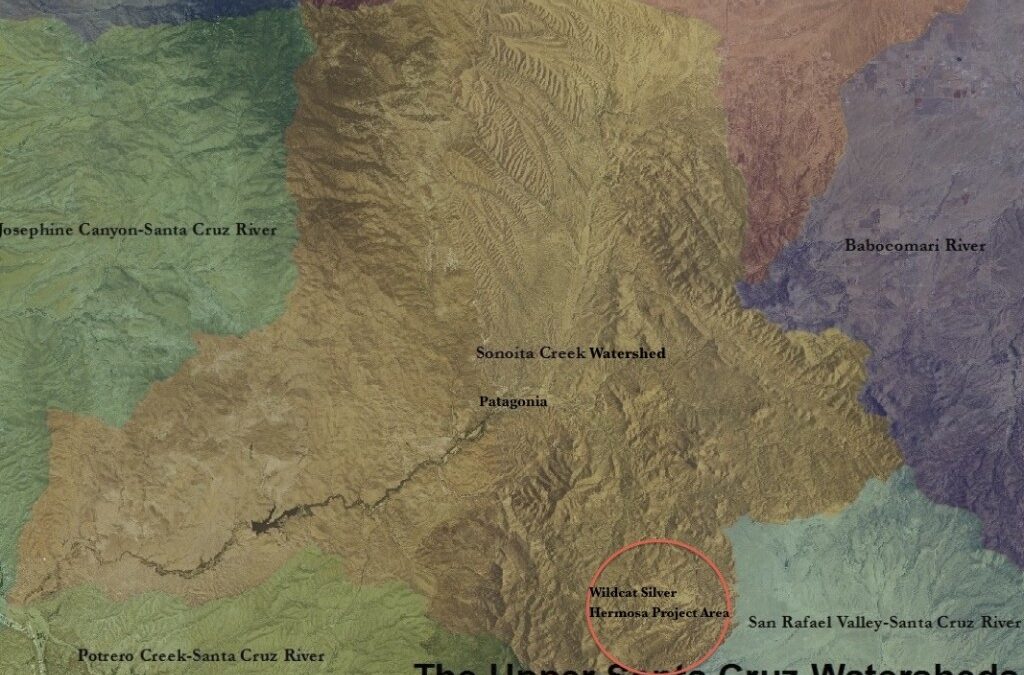
By Bryan Junger
As a citizen of Patagonia and environmental engineer, I got a real kick out of Greg Lucero’s opinion piece published March 19 in The Bulletin, entitled Town Water Supply: Fact vs. Fiction. As the title suggests, this piece is chock full of fiction, but I was unable to positively identify a single fact, other than Lucero’s name and title. I enjoy active reading, so trying to figure out which (if any) of Lucero’s statements were actually true was a welcomed exercise.
The first false statement Lucero makes is about the designation of Sonoita Creek Watershed as a “municipal” watershed, an issue that Jim Upchurch Forest Supervisor from the Coronado National Forest put to rest at a public meeting in Patagonia on March 24, 2014. Upchurch told Patagonia citizens that the Forest Service already considers Sonoita Creek to be a municipal watershed.
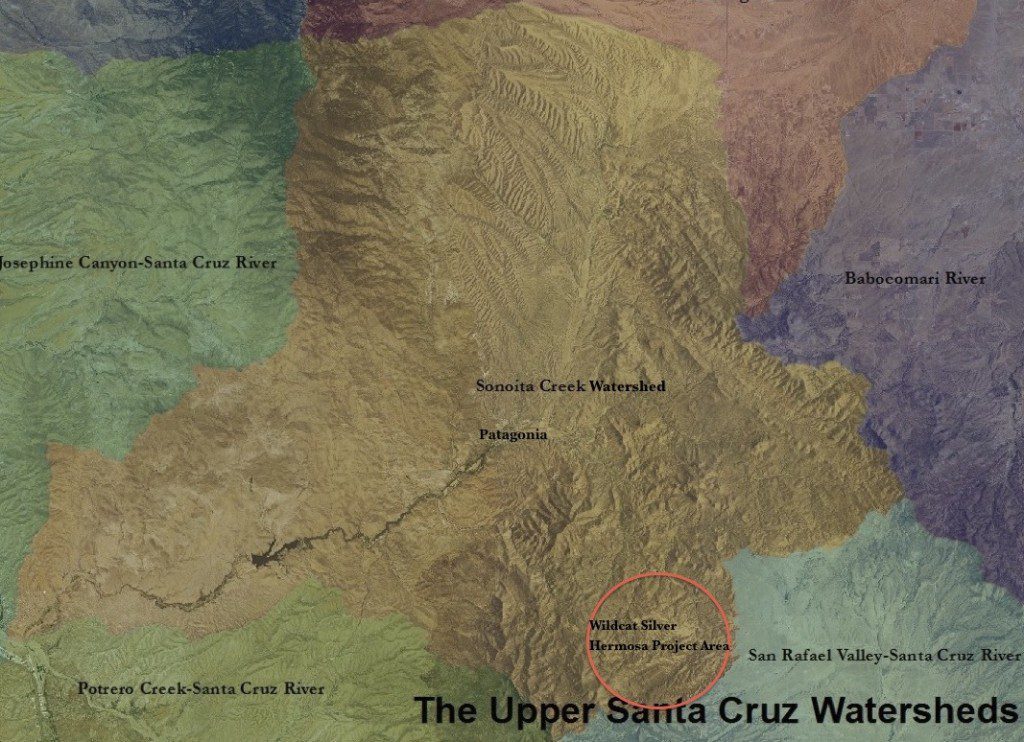
The municipal watershed designation may not preclude the use of Forest Service land for mining, as it is authorized by the US Mining Laws of May 10, 1872. These laws secure a “free entry” system forged under a frontier mentality, from a time when mining was the “first and best use of the land,” though these laws have since been modified to include amendments for the provision of “sound environmental practices.”
As VP of Sustainability for AZ Mining Inc / Wildcat Silver, I can only presume that Mr. Lucero is at least partially responsible for ensuring that his company operates according to sound environmental practices. Judging from the statements made in his recent article about our town’s water supply, we might assume that Mr. Lucero has a background in environmental analysis, hydrology, geology, or perhaps some form of engineering. The fact is, Mr. Lucero holds a B.A. in Political Science from the University of Arizona and has worked primarily in management positions throughout his career. By no measure does he appear to be an expert of hydrology, geology, environmental science, or related fields.
Two of the assertions made in Mr. Lucero’s article are the most glaringly inaccurate, in my mind:
In an effort to help combat misinformation about our watershed and also to work toward responsible management and improvement, local citizens and stakeholder groups are in the process of forming a Watershed Improvement Council (WIC) as part of an effort to consider our watershed, its health, and its many uses carefully so that we can continue to enjoy its services in perpetuity. If you are interested in learning more or becoming involved, please send me a message at bryan.jungers@gmail.com.
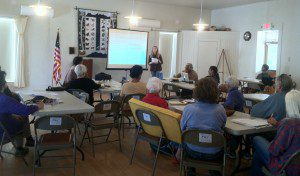
PARA, Jenny Neeley and Sergio Avila from Sky Island Alliance teamed up again to host a NEPA comment workshop at Cady Hall in Patagonia on March 26, 2014. Discussed were the potential issues of the Forest Service’s Draft Environmental Assessment of the AZ Mining Inc / Wildcat Silver / Arizona Minerals Hermosa mining exploration proposal and how to comment effectively on it.
 Jenny Neeley reprised her role as our National Environmental Policy Act (NEPA) expert for tips on filing public comments on the Hermosa draft Environmental Assessment (EA) released by the Coronado National Forest. The purpose of an Environmental Assessment is to determine whether the impacts of a project will be significant. The goal for our comments on the draft EA is to demonstrate that the Hermosa project impacts will be significant so that the Forest Service conducts a more detailed and comprehensive Environmental Impact Statement. Read more tips for writing comments here.
Jenny Neeley reprised her role as our National Environmental Policy Act (NEPA) expert for tips on filing public comments on the Hermosa draft Environmental Assessment (EA) released by the Coronado National Forest. The purpose of an Environmental Assessment is to determine whether the impacts of a project will be significant. The goal for our comments on the draft EA is to demonstrate that the Hermosa project impacts will be significant so that the Forest Service conducts a more detailed and comprehensive Environmental Impact Statement. Read more tips for writing comments here.
PARA board member Cliff Hirsch gave a summary of the expected activities proposed by the AZ Mining Inc / Wildcat Silver / Arizona Minerals Hermosa exploratory drilling project located 6 miles southeast of the Town of Patagonia. The project activities encompasses 7350 acres of both Coronado National Forest and private land. It is also expected to use 3,525,800 gallons of groundwater pumped from within the Town of Patagonia Municipal Supply Watershed. Click here for talking points and Hermosa project summary.
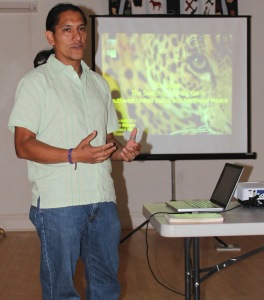
SIA Biologist, Sergio Avila
SIA biologist Sergio Avila discussed the amazing biodiversity found in the Patagonia Mountains during the Bioblitz event conducted in April 2013. View the Bioblitz report here. The results from the Bioblitz and the ongoing wildlife tracking in the Patagonia Mountains demonstrate the importance of the Patagonias as a wildlife corridor and biological hotspot in the sky island mountain ranges of southern Arizona and northern Mexico. Click for a list of Federally Threatened, Endangered and Sensitive Species in the Patagonia Mountains of the Coronado National Forest in southern Arizona.
The Hermosa draft Environmental Assessment is available at the Patagonia Public Library and online at the Forest Service website on the Hermosa project page: http://www.fs.fed.us/nepa/nepa_project_exp.php?project=41158.
Thank you everyone for your participation. The Forest Service received 200 public scoping comments on the Hermosa Plan of Operation. Let’s send them 200 more on the draft EA! Deadline to submit comments is Friday, April 11, 2014.
By Jenny Neeley
1. Consider whether the effects significant. If they are, then the Forest Service must prepare a more detailed Environmental Impact Statement (EIS) rather than an Environmental Assessment (EA). When deciding whether the impacts are “significant” NEPA implementing regulations (40 CFR § 1508.27) require that agencies consider both:
2. Make your comments “substantive” and specific. The Forest Service is required by law to respond to all “substantive” comments submitted during the public comment period; the more specific and focused your comments are, the more detailed the response must be from the agency. Comments that simply say “I am opposed to this project” will not, by themselves, require a response from the agency.
3. Include the specific sections, pages and/or topics you are referencing in the Draft EA. To the extent you can, direct your comments to specific sections, pages or topics in the Draft EA, recognizing that some comments may be addressing missing or incomplete information, or even missing topics, that you feel should be addressed.
4. Make your letter personal! Your personal connection to the Patagonia Mountains and surrounding area is an incredibly important part of your comment letter. You should explain how will you be personally impacted if this proposal moves forward. Include information about how it will affect your home, your land, your family, and/or your business and livelihood. This is a great way to start your letter and to frame the rest of your comments, and will help get the Forest Service’s attention.
See our NEPA Resources page: http://www.patagoniaalliance.org/nepa-resources/
More information about Wildcat Silver at: http://www.patagoniaalliance.org/wildcat-silver/
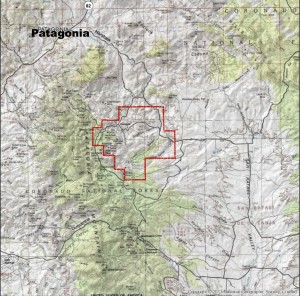
Assist PARA in protecting our precious and imperiled natural resources such as clean water and wildlife, and actively advocate for the preservation of those resources by opposing AZ Mining Inc / Wildcat Silver’s draft EA drilling exploration plan.
Deadline to comment is Monday, April 7, 2014. The Hermosa draft EA is available online at the Forest Service project webpage:http://www.fs.fed.us/nepa/nepa_project_exp.php?project=41158.

Hermosa Drilling Proposal Location
Include your name, postal address, title of the project (Hermosa Drilling Project) and signature (or verification of identity upon request.)
Comments may be submitted as follows:
Email: Electronic comments including attachments may be submitted by email in word (.doc), rich text format (.rtf), text (.txt), portable document format (.pdf), and hypertext markup language (.html) to: comments-southwestern-coronado@fs.fed.us with subject: Hermosa Drilling Project.
Facsimile: 520-388-8305, ATTN: Margie DeRose
U.S. Mail: Coronado National Forest, ATTN: Margie DeRose, 300 W. Congress St., Tucson, AZ 85701
Hand-delivery: 6th floor, 300 W. Congress St., Tucson, AZ 85701. Monday through Friday, 8 a.m. to 4:30 p.m., excluding Federal holidays.
Only individuals who submit comments about this proposed project during this public comment period will be eligible to file an objection.
AZ Mining Inc / Wildcat Silver’s Pre-Feasibility Study contains a wide range of information about the open pit mine they want to dig in the Patagonia Mountains. PARA and Earthworks are coordinating to analyze AZ Mining Inc / Wildcat Silver’s pre-feasibility study so that the community can fully understand the impacts of the proposed open pit mine.
Earthworks is a national non-profit organization based in Washington D.C. that is “dedicated to protecting communities and the environment from the impacts of irresponsible mineral and energy development while seeking sustainable solutions. Earthworks stands for clean water, healthy communities and corporate accountability.”
By teaming with Earthworks and commissioning this report, the dangers of mining in the Patagonia Mountains can no longer be dismissed as opinion, but will present a meaningful and credible analysis highlighting specific and anticipated impacts from the proposed AZ Mining Inc / Wildcat Silver open pit mine.
We are fortunate to have a group of amazing and committed community members and generous donors supporting our work that make everything we do for the Patagonia area possible.
Please consider a gift today to ensure that we have the scientific analyses necessary to actively challenge the Hermosa proposal and AZ Mining Inc / Wildcat Silver’s web of obfuscation. You may contribute securely online at: www.patagoniaalliance.org/donations. Also, please consider a recurring monthly contribution through PayPal.
Every single contribution makes a sizable difference in our organization and ultimately for the community of Patagonia. It is only because of the generous support from people like you that we can undertake this critical work. Thank you!
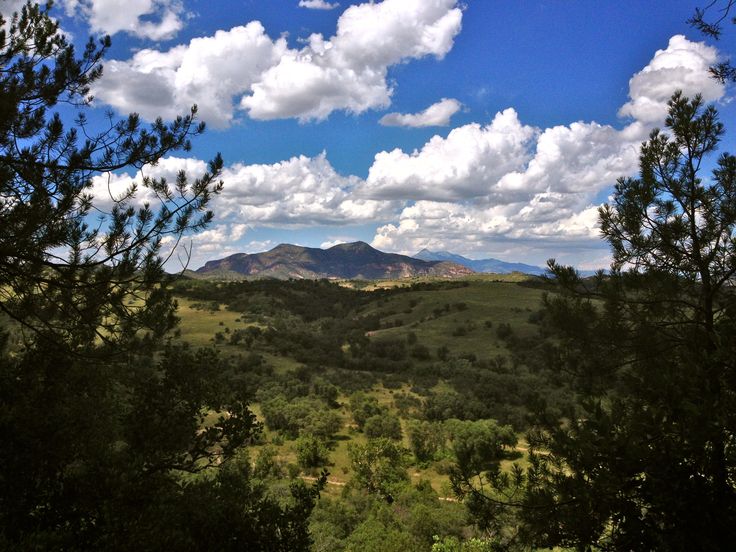
One site of Hermosa Mineral Drilling Proposal: Corral Canyon in the Patagonia Mountains.
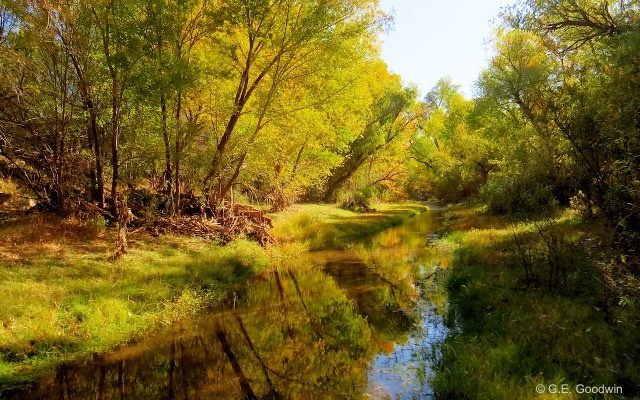
By Michael Stabile
Our municipal watershed is the only source of potable water for the Town of Patagonia and over 300 private well users within a three-mile radius of town. The recent article in the PRT about the drop in the town’s water table and the subsequent discussion of possible water rationing is a wake up call to all residents of Patagonia.
Water is taken for granted; we all just assume that we will be able to turn the tap and water will flow. Thirteen years of drought and climatologists’ model of drier years to come should affect the way we use this precious resource. We should all do our part to conserve water.
At a recent meeting of the town council it was decided to have a further discussion with town residents on cutting back on their water usage voluntarily. Where else might the Town Council look for water protection? How about opposing industrial mining impacts on the community water supply?
The Rosemont project is projected to use 6,000 acre feet of water per year. That’s almost two BILLION gallons of groundwater. The Sonoran Institute’s water study calculated that the effects of this drawdown of the water table could possibly be felt as far away as Patagonia and could in turn, have a great effect on the Sonoita creek drainage.

Sonoita Creek, part of the Patagonia Municipal Water Supply
The AZ Mining Inc (Wildcat Silver) Hermosa project is located in the headwaters of the Harshaw creek drainage. When AZ Mining Inc / Wildcat Silver’s first Preliminary Economic Assessment was issued for investors, the project covered about 3,000 acres. The project has since grown to 13,666 acres, and the open pit has expanded by at least 30%, according to AZ Mining Inc / Wildcat Silver’s Pre-Feasibility Study released in December 2013. When Chris Jones, AZ Mining Inc / Wildcat Silver’s then CEO, gave a presentation to Patagonia residents in 2010, he said that the water usage would be 450,000-700,000 gallons of water per day. Estimating water usage from AZ Mining Inc / Wildcat Silver’s own formula and data (one-half ton water for each ton of ore processed), the Hermosa open pit mine would potentially consume almost two million gallons of water per DAY. By comparison, the town of Patagonia uses roughly 115,000 gallons of water per day. Even if everyone in town conserves water by 20%, it amounts to only 23,000 gallons per day. It will have very little impact if these mines go into operation.
These two mines would use close to three billion gallons of groundwater per year. The Town should take a stronger stance on the real threat to our water supply. We can conserve all the water we want, but it would be nothing in comparison to the amount of water consumed by proposed mining.
We live in a desert. We are in a drought with long-term scientific forecasts for increasing water shortages. Water is simply the most precious commodity we have. Water is far more precious than a few jobs promised to us.
Michael Stabile was the chairman of Patagonia’s Planning and Zoning commission, and at present is a Board member of PARA. He worked with Patagonia Town Manager David Teel to get the Sonoita Creek and Harshaw Creek drainages designated as the Town of Patagonia Municipal Supply Watershed.

By Wendy Russell
The Patagonia Area Resource Alliance and Earthworks are working together to analyze AZ Mining Inc / Wildcat Silver’s Hermosa open pit mine plans so that our community can better understand its likely impacts. Earthworks is a national non-profit organization dedicated to protecting communities and the environment from the impacts of irresponsible mineral and energy development while seeking sustainable solutions. Earthworks stands for clean water, healthy communities and corporate accountability.
By reading reports that AZ Mining Inc / Wildcat Silver has recently released to investors which contain detailed information about its mining plans in the Patagonia Mountains, one can understand the purposes behind its current drilling exploration proposal of “drilling 24 geotechnical boreholes, 10 exploration boreholes and 12 hydrogeologic boreholes / monitoring wells, and excavating 16 test pits.” Spoiler alert: the sole purpose of the drilling proposal is to advance an open pit mine plan.
One purpose of the monitoring wells, as described in a January 2014 AZ Mining Inc /Wildcat Silver report, is to help “determine the quantity, location and pumping rates required to dewater the pit.” By the second year of mining,AZ Mining Inc / Wildcat Silver’s open pit would go below the water table, and water would be seeping into the pit. In order to mine,AZ Mining Inc / Wildcat Silver would have to continuously pump out this groundwater. The study says, “This creates a cone of depression around the pit allowing mining to take place.” What the report does not say is that this “cone of depression” will lower groundwater levels of the broader landscape. A rough calculation of groundwater pumping required by the mine would be 670 million gallons of water annually. To put this in perspective, the groundwater level for the town of Patagonia has already dropped nearly 18 feet since 2008, and the town uses approximately 42 million gallons per year. Wildcat’s mining would require 15 times that amount.
The geotechnical exploration that is slated to occur primarily in Corral Canyon and Goldbaum Canyon is also for AZ Mining Inc / Wildcat Silver’s open pit mine plans. Corral Canyon is described in AZ Mining Inc /Wildcat Silver’s report as “an optimal location for siting the TSF [Tailings Storage Facility]. Tailings typically contain dangerous chemicals, including arsenic, lead, mercury, and processing chemicals like acids and cyanide. AZ Mining Inc / Wildcat Silver notes that Corral Canyon is “at the top of the watershed.” It is also the top of the Patagonia Municipal Supply Watershed, the sole source of drinking water for the town of Patagonia and an additional 300 area wells.

Corral Canyon in the Patagonia Mountains, proposed site for AZ Mining Inc / Wildcat Silver’s mine tailings piles.
AZ Mining Inc /
Goldbaum Canyon is the planned location for AZ Mining Inc / Wildcat Silver’s Waste Rock Storage Facility. Waste rock is rock that does not contain desired minerals. It often contains iron, which can transform to produce acid run-off when exposed to air and water. This phenomenon is known as acid drainage. Acid drainage is irreversible and is already an ongoing issue from historic mines in the Patagonia Mountains.
The 10 exploration holes proposed in the current drilling plan, whose purpose is to prove the extent of the silver deposits, are essentially the same exploration holes AZ Mining Inc / Wildcat Silver proposed in 2011 but withdrew when PARA, Defenders of Wildlife, and Sky Island Alliance sued the Forest Service over its approval of Wildcat’s plans.
By reading AZ Mining Inc / Wildcat Silver’s reports to investors, it becomes clear that the only purpose of the Hermosa drilling proposal is to further develop an open pit mine plan. It is most certainly not a water study done for the benefit of the Town of Patagonia–a concocted assertion put forward by supporters of the mine. A peer-reviewed study of AZ Mining Inc / Wildcat Silver’s mine plan being prepared by PARA and Earthworks will provide the facts and detailed information on anticipated risks to our groundwater, the potential for acid drainage contamination, and heavy metals pollution, as well as the range of issues associated with air pollution, light and noise pollution.
By Wendy Russell
In January, the Forest Service (FS) was slated to issue a Categorical Exclusion (CE) decision for Regal’s exploratory mineral drilling proposal in Humboldt Canyon in the Patagonia Mountains. This would indicate that the FS considers their proposal to be “without significant environmental impacts.”
In the past, a CE decision would allow a company to proceed with their proposed project immediately. However, the FS now offers an administrative appeal process for projects given a CE Decision. Anyone who commented on Regal’s Sunnyside proposal during the initial scoping comment period is entitled to participate in the appeal process. Once the decision is issued, the FS will publish a notice in the Nogales International newspaper, which starts a 45-day window within which to file an appeal to the FS.
PARA plans to assist folks in submitting objections during the appeal process. We will post the workshop date in our Newsletter, Events Calendar, and on our social media sites. Jenny Neeley, former Conservation Policy Director & Legal Counsel for Sky Island Alliance, will be leading that workshop.
In an update from Coronado National Forest Sierra Vista District Ranger Mark Ruggiero, there’s been a delay in issuing the CE Decision for Regal Resources because the mining company is supposedly experiencing financial difficulties.
In another ongoing NEPA process in the Patagonia Mountains, the release of a Draft Environmental Assessment for AZ Mining Inc / Wildcat Silver’s Hermosa exploration proposal is also anticipated. The National Environmental Policy Act (NEPA) requires a “detailed statement” on the impacts of any proposed action that may “significantly affect the quality of the human environment.” Projects with anticipated environmental impacts get classified by NEPA as either requiring an “Environmental Assessment” or an “Environmental Impact Statement.” An Environmental Assessment (EA) is a brief analysis used to determine the significance of impacts resulting from a proposal. The EA is first released in draft form for public review and comment.
Coronado National Forest Sierra Vista District Ranger Mark Ruggiero issued a letter on December 18, 2013, announcing the anticipated Draft Environmental Assessment for the AZ Mining Inc (Wildcat Silver / Arizona Minerals) Hermosa Plan. Its release will trigger a 30-day public comment period before a final decision is issued. The letter also reported that in response to numerous comments received during the first scoping period, revision was made to the Hermosa Plan of Operation (Plan) “in order to reduce identified conflicts as to cultural resources.” The revised Plan is available on the Hermosa Drilling Project page on the Forest Service website: www.fs.fed.us/nepa/nepa _project_exp.php?project =41158. The changes are summarized in Appendix G.
If you have further questions about the Hermosa Plan, contact Margie B. DeRose, Geologist/Hermosa Project Manager, Coronado National Forest at (520) 388-8341 or mbderose@fs.fed.us.
Tell the Coronado National Forest that a full Environmental Impact Statement (EIS) is necessary when considering AZ Mining Inc (Wildcat Silver / Arizona Minerals) proposed Hermosa mineral drilling exploration project. Sign Petition here!
PARA is mobilizing community members to respond to the Hermosa Draft EA comment period. We will post the workshop date in our newsletter, Events Calendar, and on our social media sites. Jenny Neeley, former Conservation Policy Director & Legal Counsel for Sky Island Alliance, will be leading the workshop.
The Forest Service has released the Final Environmental Impact Statement (FEIS) for the proposed Rosemont Copper Mine Plan. In a new procedure for the Forest Service, an objection period is now available on the FEIS only for those parties who previously submitted scoping comments on Rosemont. The objection period started January 1 and is scheduled to end February 14.
Objections, including attachments, must be filed via mail, fax, email, hand-delivery, express delivery, or messenger service (Monday through Friday, 8:00 a.m. to 4:30 p.m., excluding holidays). Send to: Reviewing Officer, Southwest Region, 333 Broadway SE, Albuquerque, NM. 87102; by FAX to (520) 842-3173 or email to objections-southwestern-regional-office@fs.fed.us. For more information, contact Mindy Sue Vogel, Coronado National Forest, 300 W. Congress, Tucson, AZ, 520.388.8327, msvogel@fs.fed.us
Rosemont is now proposing a high volume of traffic through Patagonia. Rosemont’s FEIS now has added delivery routes for copper concentrate to Guaymas, Mexico. Highway 82 from Sonoita to Nogales is slated to be one of the delivery routes of copper concentrates from the proposed Rosemont mine. Trucks could be expected to make up to 56 round trips per day through Patagonia.
The Coronado National Forest (CNF) has prepared a Draft Land and Resource Management Plan, to update the current management plan, which was written in 1986. The public review period has already started, with deadline to comment on February 20, 2014.
UPDATE: The Forest Service has announced an extension of the public comment period. It has been extended an additional 14 days ending on March 6, 2014.
The Draft Forest Plan can be found on the Forest Service website: www.fs.usda.gov/detail/coronado/landmanagement/planning/?cid=fswdev7_018673. If you have questions or would like more information, please call the CNF office at 520-388-8300. Tell the receptionist you want to speak to someone about Plan Revision. You will be connected with one of the Plan Revision Core Team member.
Comments can be submitted via: Coronado Forest Plan Revision P.O. Box 1919 Sacramento, CA 95812, by fax (916) 456-6724 (Subject: Coronado National Forest, Plan Revision); or by email to CoronadoNF@fscom-ments.org (Subject: Coronado National Forest, Plan Revision).
Area conservation organizations have formed working partnerships in order to effect management recommendations to the new Forest Plan. The Coronado Planning Partnership (CPP) formed in 2006 in response to the Coronado National Forest initiating revision of its Forest Plan. The Partnership includes nearly 40 groups and landowners devoted to influencing and overseeing the new Forest Plan. Their mission includes promoting “the protection of wild species, their habitats, and ecological communities, as well as the processes that sustain them, on the Coronado National Forest.” The Partnership has released a report, State of the Coronado National Forest: An Assessment and Recommendations for the 21st Century, that they encourage the public to use to formulate their own comments on the Draft Forest Plan. It can be found on their website: www.skyislandaction.org/state_of_coronado.html.
CPP member, the Arizona Wilderness Coalition, is holding two meeting to encourage folks to comment on the Draft Forest Plan on February 6, 5-7pm, at the Martha Cooper Library 1337 N. Catalina Ave, Tucson and February 13, 6-8pm, at REI 160 W Wetmore Road, Tucson. Please check the CPP website for additional information: www.skyislandaction.org/cpp.html
Manuel Coppola wrote an editorial “Mine permitting takes too long” in the Nogales International (Jan 21, 2014).
He used the proposed Rosemont Copper mine and Wildcat Silver [AZ Mining Inc] exploration proposals as examples of the problem and cites House Bill HR 761 as the solution. The bill would speed up permitting on federal lands to 30 months vs. the current seven to 10 years.
Here’s our response to the editorial:
Perhaps we can lay the blame on the length of permitting on the fact that mines are still governed by the 1872 Mining Law. Mining, as well as the rest of the world, has changed vastly in the last 142 years. What hasn’t changed is that gold, silver, copper and other minerals extracted by mining companies are given away for free because of the 1872 Mining Law. Taxpayers receive no royalties for minerals mined on public land.
Instead of trying to speed up this antiquated law with a bill like HR 761–kind of like making a horse and buggy travel at supersonic speeds–we should reform the 1872 Mining Law to include such improvements as making mining companies pay for the minerals they extract and also paying towards the inevitable toxic burden mines create. Our U.S. Representative, Raúl Grijalva, introduced HR 2467, the Abandoned Mine Lands Cleanup and Taxpayer Fairness Act, a bill to modernize U.S. mining law and establish a royalty program to increase taxpayer return on investment. It also creates an abandoned mine cleanup fund.
The Arizona State Mining Inspector has identified at least 1,200 potentially hazardous abandoned mines in Arizona. Current mines are no better. In the EPA’s 2011 Toxic Release Inventory, Arizona mining companies account for 7 of the top 10 facilities with the largest toxic releases. That’s over 81.4 million pounds of toxic chemicals released into the air, water and land in Arizona.
The proposed Wildcat Silver [AZ Mining Inc] mine is situated at the headwaters of Harshaw Creek in the Patagonia Mountains. Harshaw Creek and Sonoita Creek are the primary sources of the Town of Patagonia’s drinking water. The historic mines in the Patagonia Mountains polluted Harshaw Creek and still produce acid runoff. The size of those historic mines operated over 50-100 years ago are a drop in the bucket compared to the size of the proposed Wildcat Silver mine. Will Patagonia’s drinking water survive a toxic chemical release at the Wildcat Silver mine? Will there be enough water for the town and the Wildcat Silver mine? We should all know the answers to those questions and more before any mining starts in the Patagonia Mountains. The water pollution and acid drainage caused by an open pit mine could pollute Patagonia’s drinking water in perpetuity.
Wendy Russell
Coordinator
Patagonia Area Resource Alliance


|
||||||||||||||||
|
By Wendy Russell
The Forest Service has re-opened the public comment period for the Regal Resources Sunnyside mining exploration project in Humboldt Canyon. This is the same project that had an earlier scoping period back in November 2011. According to the scoping notice from the Coronado National Forest, Sierra Vista District Ranger Mark Ruggiero has “decided to offer another scoping period in conjunction with this formal comment period to ensure that public involvement is current and comprehensive.”
Regal Resources Inc. is a junior mining company based in Canada. Its property in the Patagonia Mountains consists of 295 claims on the Coronado National Forest totaling approximately 5,900 acres. The scoping notice states that the Sunnyside mining exploration project is for 6 exploratory drilling sites to collect core samples to assess potential copper mineralization in Humboldt Canyon. The operation would run 24 hours a day, 7 days a week. Water would be hauled in and access for the project would be from the town of Patagonia by way of Harshaw Road, aka National Forest System Roads 49 and 58. Access within the project area would be via NFSR 812 and 4685.
According to the scoping notice, “if you submitted comments in 2011 regarding the Sunnyside project, you MUST advise us [Forest Service] in writing that you would like your previous comments to be considered as responsive to the legal notice for eligibility to appeal the decision: you do not have to resubmit your comments.” If you did not receive the scoping notice and would like to receive that information from the Forest Service contact Patrick Morton, FS Geologist, at (520)388-8348 or pmorton@fs.fed.us.
Link to Scoping Notice for Sunnyside mining project
Link to Sunnyside Plan of Operation
Link to USFS project page for Regal Resource’s Sunnyside project in Humboldt Canyon.
The Patagonia Area Resource Alliance co-hosted a comment writing workshop with Sky Island Alliance on Thursday, August 1 at 6:30 PM in Cady Hall to assist folks who want to comment on the Sunnyside project. It is our only opportunity to get the Forest Service to examine all aspects of this mining exploration project that may concern us as local citizens who live and enjoy recreation around the Patagonia Mountains. Remember, you’re only eligible to challenge the decision rendered by the Forest Service regarding this exploratory drilling project if you submit a comment within the 30-day comment period. The estimated deadline for comments is August 10, 2013.
We will be posting comment suggestions and a template from that workshop.
If you wish to submit a comment:
Please include the project name (Sunnyside Project) in the subject line of your response and/or email.
Comments may be submitted as follows:
Email: comments-southwestern-coronado@fs.fed.us
Facsimile: 520-388-8305, ATTN: Patrick Morton
U.S. Mail: Coronado National Forest, ATTN: Patrick Morton, 300 W. Congress St., Tucson, AZ 85701
Hand-delivery: 6th floor, 300 W. Congress St., Tucson, AZ 85701
Monday through Friday, 8 a.m. to 4:30 p.m., excluding Federal holidays
Also note: the Wildcat Silver Hermosa mining exploration project opened its public comment period in early August.
By Carolyn Shafer
PARA board member
Published in the Patagonia Regional Times, August 2013.
“We Dig Jobs” is a new bumper sticker seen around town. Recently released reports state that while employment has improved in Santa Cruz County there remains a high unemployment rate–so let’s talk about jobs.
Around 1960 the last mines closed. Jobs evaporated over night. While ranching continued in Eastern Santa Cruz County, the economy was rebuilt around tourism. The region became known as a world wide destination for birders and a destination for USA visitors especially our fellow Arizonans because of its significant biological diversity. Building on the strong economic base of ranching and tourism, other industries such as local food production, wineries (USA Today lists this region as one of the top ten wine trails in the country), eco-tourism and heritage tourism are contributing to the economic growth and employment opportunities.
In December 2011, the Mountain Empire Business Survey identified 217 small local businesses that employ about 800 people. Economist Dr Tom Powers analyzed the survey and concluded that 51% of business sales and about half of the jobs are attributable to landscape and cultural amenities (hiking, biking, hunting, birding, equestrian activities, ranches, relaxation getaways, health and wellness, historic and cultural sites, artisans and artists, dining, shopping). Mining will destroy the landscapes and the cultural amenities and as a result about half the business revenue and half of the 800 existing jobs will be gone.
Corporate representatives of AZ Mining Inc (Wildcat Silver) were recently quoted in the media saying that the Hermosa mining project will bring 250 jobs. However, it appears likely that this community could lose 400 existing jobs because of mining. It is doubtful that many of the 200+ local businesses could survive a 50% loss of revenue likely to result from destruction of landscapes by mining. AZ Mining Inc (Wildcat Silver) projects that the open pit mine would operate for 16 years assuming best case scenario. After which, once again those mining jobs would be gone.
One thing we can do is proactively engage our local unemployed citizens in vocational and educational assessments and other employment services provided by Santa Cruz County Career One Stop. Let’s create a community reality of an economic model that emphasizes job stability, environmental sustainability, equitable economic justice, and the well-being of the individual and the family as more important than the rate of financial return for only a select few.
AUTHOR’S FOOTNOTE: I asked the AZ Mining Inc (Wildcat Silver) representative for specific information regarding the classification of those jobs including salary ranges and qualifications (education, experience, skills). I have been told that information will be provided in a document currently being reviewed for release to the company’s investors. Wildcat Silver’s website states that the production jobs will be 12-hour shifts on a rotating night /day shift schedule (four night shifts, three days off, three day shifts, one day off, three night shifts, three days off, four day shifts, seven days off.)

With permission, we’ve re-posted John Davis’s Blog from the Wildland’s Network TrekWest Journey.
With Patagonia Area Resource Alliance, Sky Island Alliance and Defenders of Wildlife, Early March
“A veteran fence-cutter myself (always legally, of course, removing old barbed wire from various wild way lands where I work back East), I could almost feel the sense of liberation as Sergio described taking the fence out of a wildlife corridor…”
Lobo stood with us symbolically atop American Peak as we gazed worriedly down on the proposed site of the Wildcat Silver Mine (below right). Lobo is a promise, an artistic expression of hope crafted by a Zuni sculptor. This small figurine and others (including jaguar and ocelot, which are also both native to southern Arizona but jeopardized by roads and the border wall) we bear with us on this wild walk-about. The proposed Wildcat Silver Mine is a curse visited upon the good wildlife and people of the Patagonia Mountains and surrounds. If the Wildcat Silver Mine plans are approved, the Southwest will lose a critical wildlife corridor, vibrant waters, and scenery to live for.
Patagonia Area Resource Alliance (PARA) and kindred groups aim to prevent this theft. Together with Defenders of Wildlife, Sky Island Alliance, and others, PARA is organizing local and state residents to oppose this mine. Please help them.
Our day was not all about threats and alarms, though. PARA leaders showed me Madrean oak/pine woodlands primordial in their beauty, and talked with me also about their work on sustainability. This work includes pollinator advocacy led by naturalist and writer Gary Paul Nabhan, with whom I serve on the Board of Directors of Wild Farm Alliance http://wildfarmalliance.org. As Gary’s research has shown, southern Arizona is a continental leader in diversity of bees, ants, bats, hummingbirds, and other animal groups that include pollinators critical to both native and cultivated plants. The great diversity of pollinators in the Sky Islands owes to its topographic, geologic, and vegetative diversity.
So does the Madrean Archipelago’s exceptional diversity in mammals, about which Sergio Avila of Sky Island Alliance told us as we strode the Patagonias. From atop American Peak, Sergio pointed out how these mountains, modest in stature but immense in diversity, reach south into Mexico and how parallel ranges also provide key corridors for animals like jaguars and ocelots. Sergio noted that the Sky Islands is one of the few areas north of the tropics where one can find four native cats: bobcat, cougar, ocelot, and jaguar, all of which are wide-ranging and need big wild interconnected habitats.
Sergio also pointed to the border wall, cutting across the San Rafael Valley and into the mountains, threatening to sever the connections that keep these mountains so rich. Some of the rugged areas along the border thus far have been spared the building of impassable fencing; and it should be an international conservation priority to keep these wildlife corridors wall-free. Sergio had a bit of heartening news for all of us: He and other Sky Island Alliance folks had recently spent some time, at the request of the Bureau of Land Management, removing the barbed wire along the US/Mexico border where agencies deemed a simple vehicle barrier to be enough of a deterrent to drug traffickers. A veteran fence-cutter myself (always legally, of course, removing old barbed wire from various wildway lands where I work back East), I could almost feel the sense of liberation as Sergio described taking the fence out of a wildlife corridor.
TrekWest Action: Please don’t forget, to help fight these threats, you can go to trekwest.org and sign the petition to Say YES to protecting our Fast-Disappearing Wildlife Habitat Corridors, which we will deliver to decision-makers who can speed up this important conservation need. Also support the worthy organizations featured in this blog!
For the Wild,
John
Your kind consideration of a DONATION– all to help TrekWest inspire as many people as possible to support wildlife corridors and to keep up with basic supplies and equipment — is much appreciated.
Also, thank you SPONSORS!
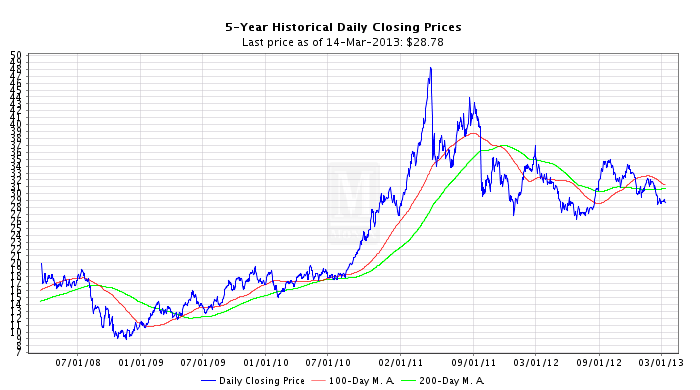
By Dave Ellis
March 18, 2013
Two news items of interest appeared on March 4. First, the announcement by Arizona Mining Inc (Wildcat Silver), “Wildcat Silver to Acquire Riva Gold”. Second, a new report by business and financial advisers Grant Thornton UK LLP that has found that “Junior Mining Companies [like Arizona Mining Inc / Wildcat Silver] are facing significant shortfalls in working capital, posing a major concern to future growth prospects.” Read full article: Money worries weigh on juniors at PDAC
With a little internet research, it is clear that the two items are closely related. First, the Arizona Mining Inc / Wildcat Silver announcement has lots of qualifiers. So, the reality is that Arizona Mining Inc / WS and Riva Gold have simply entered into a Letter of Agreement providing for the acquisition by Arizona Mining Inc / Wildcat Silver of all Riva shares at 4.7 Riva for 1 Arizona Mining Inc / WS share. Riva has C$8.1 million cash and no mineral properties or activities. So it ain’t a done deal. “The proposed acquisition remains subject to, among other things, “– the negotiation and execution of a definitive agreement and applicable shareholder and regulatory approvals.”
Further, Riva agreed to provide a C$1 million loan to Arizona Mining Inc / WS at prime + 4% maturing on 12/31/2013. So WS gets some cash to drill some more holes on or around the Hermosa property. Between the lines, this means Arizona Mining Inc / Wildcat Silver has not been able to attract investor interest and, in desperation, has to accept limited, expensive financing for further exploratory drilling.
Second, Arizona Mining Inc / WS is not alone in failing to attract precious metals investors (suckers?) There are about 1600 Junior mining companies around the world. Neither Arizona Mining Inc / WS nor Riva are even listed as Juniors! The Grant Thornton report states that “Low cash balances, coupled with broader pressures around regulatory risks and rising operating costs, have put some Junior miners at a disadvantage in the capital markets and undoubtedly some of the poorly managed entities will go bust in the near future.” (We can only hope!)
The Back Story
It is helpful to step back and look at the money game in relationship to Gold & Silver. From Wikipedia, we learn that the silver market was 490 million oz (Moz) industrial, 167 Moz jewelry, and 101 Moz investment in 2010. Industrial use transitioned gradually from pre-digital camera photography to RoHS lead-free electronic solder and Photovoltaic solar panels over a 10 year period. The jewelry market is even more stable. Thus, the “real” uses of silver metal evolve slowly. In contrast, the market for silver & gold investment changes as fast as money moves around. Like — Fast! As with the housing market from 2002 to 2008, the precious metals market is currently experiencing an investment bubble.
The graphs clearly show both the Gold and Silver “bubbles” now in their terminal downward phase.

Silver Prices
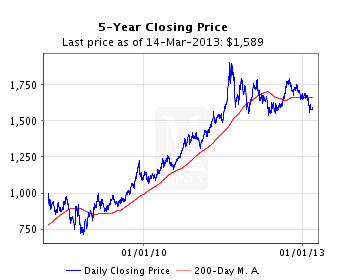
Gold Prices
Check out: http://www.google.com/finance?q=TSE%3AWS&ei=TF5DUZnFENL0rAGheQ
You will see that the price of WS stock mirrors http://www.monex.com/prods/silver_chart.html
PARA’s activism forces Arizona Mining Inc / WS to spend precious $ to move forward. So our efforts make a difference!
Notes: Silver ($45/$10 = 4.5) more volatile than Gold ($1800/$750 = 2.4). Both fast investment bubbles are due to “flight-to-safety in uncertain times”. Euro economies are stabilizing. Therefore, waning gold-silver investment goes down, so junior silver miners are struggling – duuuh!

The Patagonia Area Resource Alliance is working to stop industrial mining in the Patagonia Mountains. We are very concerned about protecting and preserving the town’s water supply. Part of our mission also includes promoting the local tourism-based economy to our surrounding public lands and parks. The interesting thing that I’ve discovered while working for PARA is that our mission overlaps or complements the mission of many other organizations both local and national. Given that we’re on the Mexican border, I can say international organizations too! One of those organizations that complements our work is Wildlands Network.
John Davis with Wildlands Network is hiking the Western Wildway of the continent from Mexico to Alaska to promote awareness of the need for wildlife corridors. The Western Wildway is a 6,000-mile-long wildlife corridor that includes Mexico, the United States and Canada. According to their website, “protecting the Western Wildway represents North America’s best chance to ensure the survival of many threatened keystone species that require long-distance movement pathways, including grizzly bear, lynx, mountain lion, wolves, jaguars, and ocelots — all faced with growing pressure from development-based habitat fragmentation and climate disruption.” Learn more at www.trekwest.org
John Davis recently traveled through Patagonia, Arizona. PARA got the opportunity to show him the area in the Patagonia Mountains that is being threatened by Wildcat Silver’s proposed open pit mine. Accompanied by Matt Clark from the Southwest office of Defenders of Wildlife and Sergio Avila from Sky Island Alliance, we climbed American Peak in the Patagonia Mountains. We discussed how the wildlife corridor for jaguars, ocelots, bears and mountain lions through the Patagonia Mountains would essentially be blocked by the proposed Wildcat Silver mine. At the top of the peak, we could see into Mexico. The Patagonia Mountains are only one of two sky island mountain ranges that cross the border into Mexico. Sergio Avila quoted a study that showed that our bear population in the Patagonias is more closely related to bears in Mexico than they are in the nearby Santa Rita Mountains. The bird’s-eye view from the top further demonstrated the importance of the Patagonia Mountains as a wildlife corridor and the vast area of the mountains that would be impacted by Wildcat Silver’s proposed open pit mine, tailings piles, waste rock, tailings ponds and processing plants. Open pit mining operations and wildlife corridors cannot coexist.

Sergio Avila with John Davis on American Peak.
Photo ©Glen E Goodwin
We were thankful for the opportunity to bring our mission to stop mining in the Patagonia Mountains to the attention of an international organization with a complementary mission to keep North American wildlife corridors open. There are so many good reasons to keep open pit mining out of the Patagonia Mountains. Keeping vital wildlife corridors open is another one.
Wendy Russell